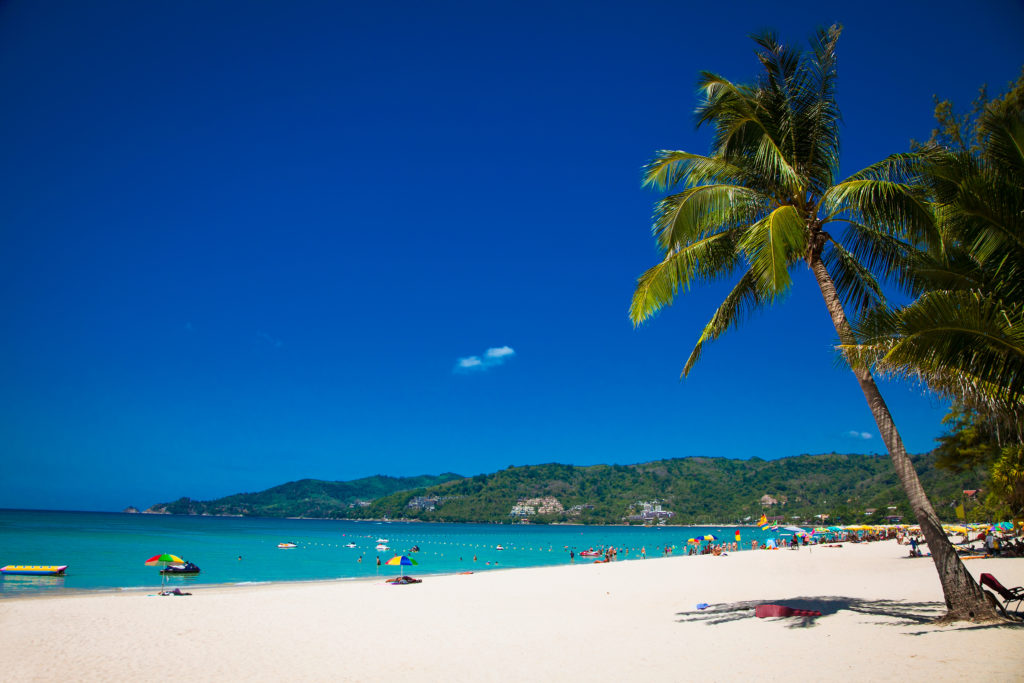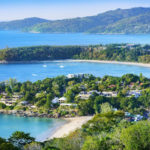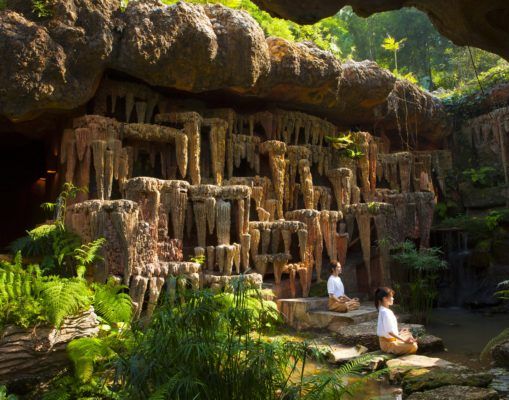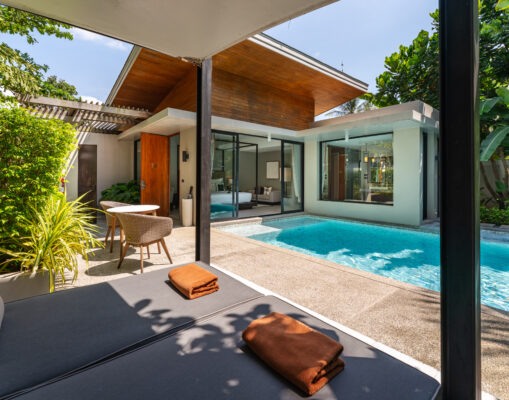
Phuket’s Famous Beaches
Phuket is famous for its beaches, and it’s easy to see why. With so many famous beaches to choose from, there are options for everyone. From snorkeling and deep diving to enjoying a relaxing seaside massage, each beach has its own unique amenities. The best time to travel to the beaches of Phuket is from November- April, during the high season when the waves are low.
Patong Beach
Located on the West Coast of Phuket, Patong Beach is a bustling beach, popular with tourists looking to enjoy the excitement of the city and enjoy Phuket’s legendary nightlife. There are also jet skis for rent, and vendors selling beach toys, massages, and more. Patong is popular, so it can get crowded, but the northern end of the beach is a bit quieter for those looking to get away from the crowds.

Surin Beach
In years past, Surin Beach was a popular tourist destination with beach chairs, vendors, shops, and hotels. In recent years these have all gone away, leaving behind the natural beauty of the lovely beach. Surin Beach is still popular with visitors who come to enjoy its pristine sand and crystal clear water. Surin is popular with kayakers, divers, and boogie boarders. Located in an area called “millionaire’s row”, Surin Beach is near world-class hotels and expensive homes, perfect for people-watching.

Freedom Beach
Located next to Patong Beach, the much less crowded Freedom beach is quieter and untouched, thanks to its limited access via boats or a very steep slope. This limits the number of guests to this pristine beach, but for those willing to put in a little extra effort to get there, it is a rewarding adventure.

Kata Beach
Kata Beach rivals the popularity of Patong, with nightlife, shopping, hotels, and dining nearby. With its soft white sand and heavenly blue waters, It is a great choice for families with children and party-goers looking to enjoy the many clubs of Phuket. There are even several hotels located along the beach.

Karon Beach
Another popular beach in Phuket, Karon Beach offers dining, shopping, a bazaar, and even a temple. Due to its large size, guests can spread out amongst the vast white expanse of sand, so Karon Beach never feels too busy. Karon Beach is also very family-friendly, employing lifeguards to patrol the beach. Sea turtles have been known to lay their eggs on Karon Beach, so beachgoers are encouraged to notify their hotel if they spot any nests so the hotel can contact the proper authorities to have the eggs protected.
A popular sporting beach, guests of Karon Beach can enjoy everything from parasailing to deep sea diving and windsurfing.

Everybody knows Phuket as a hub of busy beaches and partying from dusk till dawn at Bangla Road.
But Phuket is also modern street art, European-meets-Asian-style shophouses, baby turtles escaping to the sea, and serene temples tucked away from the crowds.
If you avoid Phuket because its more popular side isn’t your cup of tea, then you’ll also be missing out on the underlying history, culture, and nature of the area.
Old Phuket Town
Phuket’s historical district should define the region as much as Patong and the nightclubs on Soi Bangla – given its longer, more vibrant history, you might say it even holds a stronger claim.
Tin mining was the reason for Phuket’s existence long before the first tourist ever set eyes on Patong Beach. Through the industry’s heyday of the 19th to the early 20th centuries, European traders and Hokkien Chinese miners dug out a prodigious amount of tin from Phuket’s soil.
The town they built was influenced by both groups but has also managed to evolve with the times.
An evolving portfolio of street art now graces many of Old Phuket Town’s walls. Quaint little boutiques have transformed Soi Romanee, Old Phuket Town’s former red-light-district, into its most Instagrammable spot.

Thalang Road’s shophouse restaurants, boutiques, and cafes are must-sees during the day. On Sunday evenings they turn it up to eleven when the length of Thalang is transformed into a massive, pedestrians-only street market.
If you’re hungry, many of Old Phuket Town’s mansions have been artfully transformed into restaurants, where you can enjoy the classic interiors and a five-star meal. Two of the best are The Blue Elephant (a former Governor’s mansion) and the Raya Restaurant (a Michelin Bib Gourmand awardee).
Boutique and budget hotels in Old Phuket Town offer a great value and awesome atmosphere, but most tourists find Old Phuket Town’s distance from the beach — a good 20km from Patong — a bit long.

Waterfalls, Mangrove and Rainforest Retreats
The beaches are usually top-of-mind to Phuket tourists, often ignoring the virgin rainforest and waterfalls inland. Explore these authentic gems of the island.
Khao Phra Thaeo National Park conserves the last remaining fragment of rainforest on Phuket, along with its wildlife – among them the rare barking deer, gibbons, wild boar, and over one hundred species of birds.
A handful of forest trails snake through the undergrowth with the easiest one covering 600 meters through a scenic bamboo forest. A longer, 4-km-long trail connects two waterfalls—Bang Pae and Ton Sai.
With a larger footprint on the island relative to Khao Phra Thaeo, Sirinat National Park offers a bit more for the nature-loving tourist. Wooden walkways take visitors through a massive mangrove forest ecosystem, allowing occasional glimpses of animals like mudskippers, brown-winged kingfishers, and monitor lizards.
The beaches of Nai Yang, Nai Thon, and Mai Khao are part of Sirinat and provide awesome escapes from the crowded seaside scenes at Patong or Kamala beaches. To truly get away from it all, spend the night at one of Sirinat’s campsites.

Turtles and Other Animal Encounters
Party animals aren’t the only wildlife you’ll encounter on Phuket. Several other experiences are designed to initiate close — and ethical — encounters with indigenous Thai animals.
The Gibbon Rehabilitation Centre (gibbonproject.org) in Khao Phra Thaeo National Park allows visitors to watch these primates from a viewing platform. Learn more about the Centre’s efforts to rehabilitate abused pet gibbons and reintroduce them into the wild while visiting.
Adjoining Khao Phra Thaeo National Park, the Phuket Elephant Sanctuary (phuketelephantsanctuary.org) offers a responsible way to observe retired working elephants. From a safe viewing distance, guests can watch elephants swim in a freshwater pond – the park avoids elephant contact experiences like bathing or riding.
The Mai Khao Marine Turtle Foundation (maikhaomarineturtlefoundation.org) on Mai Khao Beach helps to protect the local large turtles that periodically lay their eggs on Phuket’s beaches. Daily information sessions explain the dire situation faced by turtles on Phuket. Feeding sessions allow you to meet the Foundation’s permanent guests, disabled turtles that could never survive in the wild.

Phuket’s Temples
Thailand’s places of worship reveal a beautiful side of Thailand outside of the stunning beaches. Beyond Phuket’s most important (and most tourist-heavy) holy sites – the Big Buddha near Karon and Wat Chalong near its namesake bay – you can visit one of the island’s less-trafficked temples to get in touch with its spiritual side.
The Shrine of the Serene Light in Old Phuket Town was established in 1891. The Taoist temple caters to the town’s Hokkien and Peranakan residents. A colorful arch now welcomes tourists to this once well-hidden worship site. Once inside visitors will find a small but captivating altar decorated with statuettes and scented with burning incense.
Wat Khao Rang’s Golden Buddha was Phuket’s first Big Buddha image and then overshadowed by the newer, bigger one in the Nakkerd Hills. It’s still worth a visit (usually as part of a Wat Khao Rang itinerary that includes the nearby viewpoint). With fewer tourists, you can better enjoy the sights of the Lord of Death Yommaraj, figures in Thai mythology, and the golden Buddha looking serenely over Phuket.
Wat Sri Sunthon’s Reclining Buddha is one of Phuket’s largest Buddha images, stretching some 29 meters high on top of a single-story building. Located next to Phuket’s main road, it’s worth a stop if you’re headed to or from Old Phuket Town.
Getting to Phuket
The island of Phuket is easy to visit. Most visitors come by air: Phuket Airport is Thailand’s busiest airport outside Bangkok, connecting the island to Asian, Australian, European, and Middle Eastern cities. There are also domestic flights available within Thailand for those looking to visit Phuket from cities such as Bangkok.
To get to Phuket by bus from Bangkok, go to the capital’s Southern Bus Terminal (Sai Tai Mai) and take the bus service that terminates at Phuket Bus Terminal 2 on Thepkasatri Road. The trip takes 13 hours to complete.
To get to any of the sites listed above, you can either summon one of Phuket’s metered red/yellow taxis, negotiate the use of a tuk-tuk, or use the car-hailing app Grab (grab.com/th) to call a ride.




